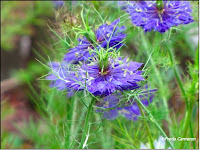| UPDATED: 5 July 2011 These are my favorite flowers to grow from seed. All photos (click to enlarge) were taken in my garden and information is based upon my experience. My garden is in zone 7b of North Carolina. Perennial seeds that require cold stratification are sown in November, based on my zone. Seeds for spring-blooming annuals (cornflowers, larkspur, nigella and poppies) are also sown in November. The time to sow seeds in your zone may be different. None of these flowers were started indoors. I direct-sowed all seeds in the garden. Any plants that can be grown from seed may also self-sow in your garden if not deadheaded. Too much of a good thing can be a problem, such as allowing bronze fennel or baptisia to self-sow, both of which have long taproots, making them difficult to pull. The flowers listed below are easy to pull from the garden. Unless otherwise stated, I've found all of these plants to be deer and rabbit resistant, but your experience may be different based upon availability of food and animal populations in your area. PLEASE KEEP ALL SEEDS OUT OF REACH OF CHILDREN AND PETS. Some plants are poisonous, so do your research before planting in your garden. All links correspond to more information on my blog, Defining Your Home, Garden and Travel. Ammi majus is False Queen Anne's Lace, not to be confused with the Queen Anne's Lace (daucus carota) that grows wild along roadsides. This is a self-sowing annual that grows about 3 feet high. Direct sow in garden in autumn in warmer zones and spring in cooler zones. Deer and rabbit resistant. Alyssum 'Carpet of Snow' or Sweet Alyssum (lobularia maritima) is a nice 12" high edging annual that blooms for a long period of time. Sow directly in garden in autumn in warm zones and late spring in cool zones. Self-sows. I haven't tested this in the deer resistant garden. Rabbits have not bothered this plant. |
 | Cornflower 'Blue Boy' (left). I am also growing 'Red Ball' and 'Snowman'. The cornflowers, also known as bachelor's buttons (Centaurea cyanus) may be considered invasive in some areas, so check your state's agricultural information before planting. Annual. Blooms in May. |
 | Larkspur 'Gailee Blue' and 'Lilac Spire' (shown left) are my favorites, but I also grow Blue Spire' and 'White King'. Annual. Blooms in May. |
 | Nigella damascena 'Miss Jekyll Blue' is proving to be a great annual. I'm using nigella in several different settings and combinations. Looks great with California poppies. Blooms in May. |
 | Poppy 'Laurens Grape' (left) was difficult to find. I'm also growing an unknown white poppy in this meadow garden. Annual. Blooms in May. |
 | Verbena bonariensis (perennial in zones 7-10) is a favorite with butterflies, bees and Goldfinches. Blooms in May until frost. |
 | Swamp Milkweed, asclepias incarnata, is a host plant for the Monarch butterfly caterpillar. Perennial in zones 3-9. Easy to collect seeds and sow in the fall. Late to emerge in spring, so be patient. Blooms in June and will rebloom with deadheading. |
 | Echinacea 'Prairie Splendor' (perennial in zones 3-9). Sow seeds in November. Deer and rabbits may sample flowers when plants are young. I have great success without damage. Blooms begin in May and will rebloom with deadheading. Self-sows true to parent. |
 | Gaillardia 'Burgundy' (perennial in zones 3-9). Sow seeds in November. Another gaillardia to grow from seed is 'Yellow Queen'. Blooms all summer and into fall with deadheading. |
 | Flax linum narbonense 'Heavenly Blue' (perennial in zones 5-9). Sow seeds in November. A wonderful filler plant. Blooms begin in April and continue off-and-on. Self-sows. |
 | Marigold 'Autumn Red' (shown), but I grow many colors quite easily. Sow seeds in May and the blooms will last through a few frosts. Annual. |
 | Papaver paeoniflorum 'Venus' (Paeony Flowered Poppy). Annual. Sow seeds in November. Give this one space as the foliage is large. It can look ratty after blooms while waiting to collect seeds from dried pods. Pull foliage when finished. |
 | California Poppy 'Purple Gleam' Eschscholzia californica, annual. Sow seeds according to zone. May bloom in spring and again in fall, depending on zone. |
 | Rose Campion, lychnis coronaria (perennial in zones 3-9) is self-sowing. The silver foliage color also provides great interest among green foliage plants. Cut back after bloom. Foliage may turn black in heat and humidity, so hide it among pretty summer perennials and annuals. |
 | Zinnia Benary's Giant (shown) is a favorite variety for bloom size, tall height and as a cut flower. Easy to grow for summer blooms. Sow seeds in May. Deer and rabbits may browse this plant, usually when other food is scarce in late August or September. Butterflies love it! Annual. |
| Renee's Garden |
| Diane's Seeds |
| Swallowtail Garden Seeds |
| Select Seeds Antique Flowers |
| Ace Hardware in Chapel Hill, NC (Livingston Seeds) |
| Southern States in Carrboro, NC (Botanical Interests) |




